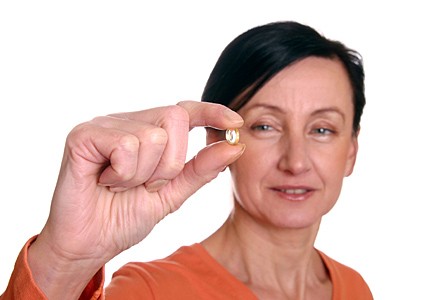Oxygen is a Jekyll and Hyde element. We need it for critical body functions, such as respiration and immune response, but the element’s dark side is a reactive chemical nature that can damage body cells and tissues. The perpetrators of this “oxidative damage” are various oxygen-containing molecules, most of which are types of free radicals—unstable, highly energized molecules that contain an unpaired electron.
Since stable chemical bonds require electron pairs, free radicals generated in the body steal electrons from nearby molecules, damaging vital cell components and body tissues. Oxidative damage in the body is akin to rusting of metal, the browning of freshly cut apples, or fats going rancid. Certain substances known as antioxidants, however, can help prevent this kind of damage. This article examines the special relationship between oxidative damage, antioxidant protection, diabetes, and complications of diabetes.
Oxidative damage
Free radicals and other “reactive oxygen species” are formed by a variety of normal processes within the body (including respiration and immune and inflammatory responses) as well as by elements outside the body, such as air pollutants, sunlight, and radiation. Whatever their source, reactive oxygen species can promote damage that is linked to increased risk of a variety of diseases and even to the aging process itself.
Oxidative damage to LDL (low-density lipoprotein or “bad”) cholesterol particles in the blood is believed to be a key factor in the progression of heart disease. Oxidative damage to fatty nerve tissue is linked to increased risk of various nervous system disorders, including Parkinson disease. Free radical damage to DNA can alter genetic material in the cell nucleus and, as a result, increase cancer risk. Cataract formation in the eye may also involve free radical damage to lens proteins. Oxidative damage has also been linked to arthritis and inflammatory conditions, shock and trauma, kidney disease, multiple sclerosis, bowel diseases, and diabetes.
Antioxidant protection
As a defense against oxidative damage, the body normally maintains a variety of mechanisms to prevent such damage while allowing the use of oxygen for normal functions. Such “antioxidant protection” derives from sources both inside the body (endogenous) and outside the body (exogenous). Endogenous antioxidants include molecules and enzymes that neutralize free radicals and other reactive oxygen species, as well as metal-binding proteins that sequester iron and copper atoms (which can promote certain oxidative reactions if free). The body also makes several key antioxidant enzymes that help “recycle,” or regenerate, other antioxidants (such as vitamin C and vitamin E) that have been altered by their protective activity.
Exogenous antioxidants obtained from the diet also play an important role in the body’s antioxidant defense. These include vitamin C, vitamin E, carotenoids such as beta-carotene and lycopene, and other phytonutrients, or substances found in fruits, vegetables, and other plant foods that provide health benefits. Vitamin C (ascorbic acid), which is water-soluble, and vitamin E (tocopherol), which is fat-soluble, are especially effective antioxidants because they quench a variety of reactive oxygen species and are quickly regenerated back to their active form after they neutralize free radicals. Small amounts of these vitamins obtained from the diet provide a great deal of antioxidant protection, but research indicates that larger doses provide little additional protection. Vitamin C, which is abundant in fruits and vegetables, is concentrated in white blood cells that generate reactive oxygen species by using oxygen to burn bacterial and viral invaders; vitamin C may protect against DNA damage in the cell. Vitamin E, found in nuts, seeds, vegetable oils, and wheat germ, among other foods, protects unsaturated fat in cell membranes and fatty nerve tissue from oxidative degradation. Carotenoids, which are colored nutrients found in fruits and vegetables, provide their own unique antioxidant protection apart from vitamins C and E. Beta-carotene, the orange color in carrots, and lycopene, the red color in tomatoes, are effective quenchers of singlet oxygen, a form of reactive oxygen species that is not a free radical but is highly reactive.
Diabetes and oxidative damage
Normally, the body maintains a balance between the amount of reactive oxygen species generated and its antioxidant defense. This balance may be tipped, however, by conditions that greatly increase the generation of reactive oxygen species (such as cigarette smoke in the lungs) and/or lack of antioxidant defense due to malnutrition. Many diseases involve increased production of reactive oxygen species, including infections and inflammatory conditions such as arthritis and inflammatory bowel diseases.
There is substantial evidence that people with diabetes tend to have increased generation of reactive oxygen species, decreased antioxidant protection, and therefore increased oxidative damage. Hyperglycemia, or a high blood glucose level, has been shown to increase reactive oxygen species and end products of oxidative damage in isolated cell cultures, in animals with diabetes, and in humans with diabetes. Measurement of the end products of oxidative damage to body fat, proteins, and DNA are commonly used to assess the degree of oxidative damage to body cells and tissues. Most studies show that these measures are increased in people with diabetes.
The activities of key antioxidant enzymes are also found to be abnormal in people with diabetes. In some studies, these enzyme activities are seen to be lower than normal, suggesting a compromised antioxidant defense, while other studies show higher activity, suggesting an increased response to oxidative stress. Some studies indicate that oxidative damage is greater in people with Type 2 diabetes compared to those with Type 1, especially people with Type 2 diabetes and the metabolic syndrome, which involves central obesity, hypertension (high blood pressure), and high blood fat levels along with insulin resistance (decreased effectiveness of insulin in metabolizing blood glucose).
There is evidence that antioxidant protection is decreased and oxidative stress increased in some people even before the onset of diabetes. For instance, increased levels of oxidative stress have been found in people who have impaired glucose tolerance, or prediabetes.
Evidence for antioxidant protection
Overall, the evidence indicates that hyperglycemia creates additional oxidative stress, and that measures of oxidative damage are generally increased in people with diabetes. Therefore, the question arises as to whether antioxidant treatment may delay or prevent diabetes, or delay the onset of diabetes complications that include cardiovascular, kidney, nerve, and eye diseases. Cell culture and animal studies support the hypothesis that antioxidants can protect diabetic cells from some damage. However, two types of human studies must also be examined to answer the question: population studies and clinical trials.
Population studies. Population, or epidemiologic, studies have looked at the relationship between antioxidant intake and the development of diabetes. They have also examined the effects of antioxidant intake on a group of people with diabetes compared to a similar group without the condition.
Examination of the diets of some 4,300 Finnish adults (40–69 years old) without diabetes showed that those with low dietary intakes of vitamin E had a significantly greater risk of developing Type 2 diabetes over the next two decades. There was no relationship between intake of vitamin C and risk of future diabetes development. In another study of 81 male and 101 female Finnish adults at high risk for Type 2 diabetes, dietary carotenoids were associated with improved measures of glucose metabolism (fasting plasma glucose concentration and insulin resistance) in men but not women. In a third study, blood levels of five carotenoids were measured in 1,597 Australian adults that were healthy or had varying degrees of impaired glucose metabolism. Those with higher blood levels of the carotenoids had a healthier profile of glucose metabolism tests—fasting plasma glucose levels, insulin concentrations, and glucose tolerance levels.
Like carotenoids, flavonoids are a class of antioxidants found in fruits and vegetables and in some plant-based beverages including tea and red wine. To study the possible benefit of dietary flavonoids for preventing Type 2 diabetes in women, dietary flavonoid intake, as well as insulin resistance and inflammation, were measured in 38,018 healthy U.S. women over an average of nine years. The results showed no relationship between intake of flavonoids and risk of developing Type 2 diabetes. However, there was a modest benefit for consumption of apples and tea.
The relationship between vitamin C and E intake and diabetic retinopathy (eye disease) was assessed in two U.S. studies of populations of 998 and 1,353 adults with Type 2 diabetes. There were no significant associations for dietary intake or blood level of the vitamins with the occurrence of retinopathy. However, one of the studies showed that those taking supplements of the vitamins for more than three years had a reduced risk of retinopathy.
In summary, population studies have shown mixed results as to possible benefits of antioxidants to people with diabetes. Some show a benefit, others show no relationship, and none show harm.
Clinical trials. Population studies are limited in that they show only associations between dietary factors and medical conditions—they do not show cause and effect. For instance, high carotenoid levels in the blood are markers for high fruit and vegetable intake: Therefore, the beneficial effects on glucose metabolism associated with carotenoids in the Australian study noted above could actually be due to other substances in the fruits and vegetables rather than the carotenoids. To prove conclusively that a dietary factor has an impact on a medical condition requires further clinical trials with better-controlled conditions. Ideally, studies to determine the potential benefit of antioxidant nutrients on disease prevention should be large and be carried out over many years. They should also be placebo-controlled (control subjects receive an inert pill which is indistinguishable from the antioxidant treatment pill) and double-blind (neither the subjects nor the investigators know who is getting the antioxidant or the placebo pills until the results are analyzed).
A number of smaller studies of people with diabetes have shown positive results with antioxidant treatments, while others have shown no benefit. Two Italian studies found that treatment of people with Type 2 diabetes with vitamin E decreased HbA1c, a measure of long-term blood glucose control, and improved markers of heart function. However, Swedish investigators found that two years of antioxidant treatment in children with Type 1 diabetes (beginning at diagnosis) had no effect on blood glucose levels, HbA1c, and insulin doses as compared to similar children receiving placebo treatment. And in a small study in Scotland, people with Type 2 diabetes who were given a low-flavonoid base diet enriched with large amounts of onions and tea (which are high-flavonoid foods) were found to have lower levels of oxidative damage to the DNA of white blood cells compared to the same subjects on the diet without the onions and tea.
In smokers and people with cardiovascular disease and/or hypertension (high blood pressure), vitamin C is known to improve the ability of blood vessels to relax and allow increased blood flow. This may be important to people with diabetes since they have a high rate of complications involving the blood vessels. In fact, studies have shown that intravenous infusion of vitamin C improves vascular relaxation in people with both Type 1 and Type 2 diabetes. However, oral consumption of large amounts of vitamin C by people with Type 2 diabetes in separate English and Swedish studies had no such effect. And treatment of 49 people with diabetes in the Boston area with combined vitamins C and E supplements for six months showed improvement in vascular function for people with Type 1 diabetes but not for those with Type 2.
Over the past two decades, large clinical trials of antioxidant supplements have been conducted with participants who had preexisting heart disease or some risk factors for heart disease such as smoking and diabetes. These studies focused primarily on the potential benefit of vitamins E, C, and/or the carotenoid beta-carotene for preventing cardiovascular disease. The studies did not specifically target diabetic populations, but the results are pertinent to people with diabetes because some were included in some of the studies and because the cardiovascular disease end points measured are some of the complications people with diabetes often develop.
A 1996 English study, the Cambridge Heart Antioxidant Study, found that vitamin E supplements given to 2,002 adults with preexisting heart disease significantly reduced the occurrence of heart attacks after one year of supplementation. These findings encouraged further studies of vitamin E. However, a number of subsequent studies did not show benefits for consumption of vitamin E supplements in amounts of 20 to 40 times the RDA (recommended dietary allowance, now 15 milligrams [mg] per day). More recently, a 2002 British study gave a trio of antioxidant supplements (vitamins E and C and beta-carotene) or placebo to 20,536 adults with cardiovascular disease or diabetes for five years. As compared to the placebo group, the people who took the supplements had substantially increased blood levels of the antioxidants, but the antioxidants had no effect on the occurrence of cardiovascular events (such as heart attack or stroke), cancer, or hospitalizations for nonvascular problems.
Some of the large antioxidant clinical trials enrolled enough people with Type 2 diabetes to assess the effects of antioxidant supplements in the diabetic group separately. In 2002, investigators from Canada, the United States, and Germany reported the effects of supplementing adults age 55 and over, who had either cardiovascular disease or Type 2 diabetes and an additional coronary risk factor, with vitamin E for an average of 4.5 years. For the group of 3,654 people with diabetes, vitamin E had no effect on incidence of heart attacks, strokes, or nephropathy (kidney disease)—all among the complications of diabetes. A 2003 Italian study tested vitamin E and low-dose aspirin for preventing heart disease and stroke in 4,495 adults age 50 and over with heart disease risk factors, including 1,031 people with diabetes. Over a median period of 3.7 years, there was no benefit found for vitamin E supplementation in either the subjects with diabetes or those without. (Low-dose aspirin was less effective for preventing cardiovascular events in the diabetic group as compared to the nondiabetic group.) Finally, a 2003 analysis and summary of 15 vitamin E and beta-carotene clinical trials (called a meta-analysis) concluded that the results showed no beneficial effect for various doses of the antioxidants in diverse populations for the prevention of cardiovascular diseases. In fact, beta-carotene supplements were shown to slightly increase risk of death from cardiovascular and all causes.
Alpha-lipoic acid
Alpha-lipoic acid (also called ALA or thioctic acid) is a unique, sulfur-containing compound that is made in small amounts in the body but is not obtained from the diet. It neutralizes a variety of reactive oxygen species and can “recycle” vitamins C and E in the body. In people with diabetes, ALA appears to enhance insulin action and blood vessel circulation, protect against diabetic neuropathy (nerve disease), and inhibit protein glycation (a reaction between excess glucose and protein that impairs the protein’s function and forms harmful end products in the body).
Some, but not all, studies have found that treating people with Type 2 diabetes with ALA improved blood glucose control and also reduced measures of oxidative stress that may contribute to diabetes complications. In one German study, people with Type 1 and Type 2 diabetes who were given 600 mg per day of ALA for 18 months had lower levels of two markers for diabetic kidney disease than a control group of people with diabetes that did not receive the ALA.
Most promising of the studies with ALA have been those that indicate benefit towards the symptoms of diabetic neuropathy. The studies have generally treated people with diabetes with 600 mg of ALA per day, either intravenously or orally, and have found improvement in both systemic and localized symptoms of neuropathy such as pain, numbness, burning sensation, foot problems, and heart rhythm problems. One specific study published in 2000 showed that both intravenous infusion and oral consumption of ALA enhanced blood vessel relaxation and improved circulation in small blood vessels in people with diabetic peripheral neuropathy. A 2004 article in the journal Treatments in Endocrinology reviewed the studies on ALA and diabetic neuropathy. The review included seven randomized clinical trials of ALA in people with diabetic neuropathy and concluded that short-term (3 weeks) intravenous infusion and long-term (4–7 months) oral consumption of ALA improved symptoms of neuropathy to a clinically meaningful degree while indicating a high safety profile for the drug.
The bottom line
Oxidative stress is strongly linked to the development of diabetes and its complications. While laboratory and animal studies show benefits from antioxidant treatments, human clinical trials of the major dietary antioxidants—vitamin E, vitamin C, and carotenoids—have been largely negative. While these natural antioxidants are generally safe, the evidence does not support their use for preventing or treating diabetic conditions. This conclusion is similar to that of the year 2000 report of the National Academy of Sciences panel on Dietary Antioxidants and Related Compounds, which states that the evidence does not warrant increased intakes of the antioxidants to protect against chronic degenerative diseases, including diabetes.
The negative findings for vitamin E, vitamin C, and carotenoids should not end the research on antioxidant protection for diabetes. Clinical trials that focus specifically on people with diabetes have not yet been conducted. Since the body limits the amount of natural antioxidants in tissue cells (including the insulin-producing pancreatic beta cells), some scientists have recently suggested that artificially created antioxidants designed to better enter the cells may provide protection against oxidative damage in people with diabetes. Others suggest that some drugs currently used to treat cardiovascular disorders, including statins, ACE inhibitors, and calcium channel blockers, provide antioxidant protection beyond their other mechanisms of action. Also, since most trials have only studied single antioxidants, studies with multiple antioxidants (such as combinations obtained from foods) should be considered. (For more information on obtaining antioxidants from foods, see “Food Sources of Antioxidants”.)
Alpha-lipoic acid has been shown to be beneficial for safely treating diabetic neuropathy, and the recent development of an oral sustained-release form holds further promise (sustained-release forms maintain more even blood levels of a drug for a longer period of time). To help determine conclusively whether ALA is effective for treating diabetic neuropathy, a large multicenter trial is being conducted in North America and Europe to assess the effects of oral treatment with ALA on the progression of diabetic neuropathy. Despite some disappointing results so far, further research holds promise for providing clinically significant antioxidant protection against diabetes and its complications.





